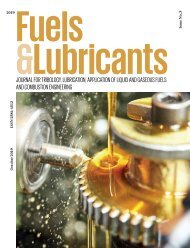Fuels & Lubricants Magazine
Issue No. 3, October 2018
Issue No. 3, October 2018
You also want an ePaper? Increase the reach of your titles
YUMPU automatically turns print PDFs into web optimized ePapers that Google loves.
GREEN CORNER<br />
fatty acids. The fatty acid from vegetable oil have<br />
cracked stem appearance so the oil molecules tend to<br />
coincide with the crystalline structure and crystallize<br />
at a lower temperature. Double bonds of unsaturated<br />
triglycerides are less compact and there are less intermolecular<br />
interactions among them. Because of this, the<br />
vegetable oils are at the ambient temperature in liquid<br />
state and fats are in solid state. Saturated oils have a<br />
better oxidation stability and a higher point of a melting<br />
point than unsaturated. A higher degree of unsaturation<br />
is also the reason for higher reactivity [6].<br />
Typical properties of used cooking oil and animal fat<br />
are shown in Table 1 and 2 respectively.<br />
Table 1. Properties of used cooking oil<br />
Property<br />
UCO<br />
Acid number<br />
1.0 – 16.0 mg KOH/g<br />
Density at 15 °C < 920.0 kg/m 3<br />
Water content < 1.0 wt. %<br />
Kinematic viscosity at 40 °C 35.0 – 45.0 mm2/s<br />
Metal content<br />
Ca<br />
10 – 120 mg/kg<br />
K<br />
20 – 90 mg/kg<br />
P<br />
5 – 65 mg/kg<br />
Fe<br />
0 – 50 mg/kg<br />
Na<br />
10 – 60 mg/kg<br />
Mg<br />
0 – 25 mg/kg<br />
Free fatty acids content < 6.0 wt. %<br />
Table 2. Properties of animal fat<br />
Property<br />
AF<br />
Acid number<br />
10 – 20 mg KOH/g<br />
Density at 15 °C > 915.0 kg/m 3<br />
Water content < 1.0 wt. %<br />
Kinematic viscosity at 100 °C 8 – 9 mm 2 /s<br />
Metal content<br />
Ca<br />
260 – 500 mg/kg<br />
K<br />
40 – 160 mg/kg<br />
P<br />
260 – 450 mg/kg<br />
Fe<br />
5 – 25 mg/kg<br />
Na<br />
70 – 180 mg/kg<br />
Mg<br />
5 – 40 mg/kg<br />
Free fatty acids content < 15.0 wt. %<br />
In Croatia, during the 2016 year, 825 tons of used cooking<br />
oil was collected which is only 0.2 kg per capita [7].<br />
During the 2016 year, 1.3 tons of UCO was recovered,<br />
which is 72 wt.% more than in the 2015 year. In addition<br />
to the accumulated amounts of UCO, the reason lies in<br />
the fact that part of the recovered amount in 2016 is collected<br />
in the previous years and comes from a collector’s<br />
storage tanks. All collected quantities, according to The<br />
Environmental Protection and Energy Efficiency Fund<br />
data, were recovered within the Republic of Croatia by<br />
energy recovery.<br />
The data from Croatian Environment and Nature<br />
Agency are generated from data reported in Environmental<br />
Pollution Register database, which includes<br />
stakeholders outside the The Environmental Protection<br />
and Energy Efficiency Fund system, shows that in 2016<br />
year 5.3 tons of UCO was collected. More than 4 tons<br />
were recovered while only 1.8 tons in Croatia and 2.3<br />
tons were exported to other EU countries. The remaining<br />
collected quantities (more than 1 ton) were temporarily<br />
stored at the authorized collector’s warehouses.<br />
The animal fats category 1 and 2 that is not used in the<br />
production of animal feed in the Republic of Croatia is<br />
about 2500 tons per year.<br />
Due to the high content of triglycerides vegetable oils<br />
and animal fats are suitable feedstock for production<br />
of biofuels such as biodiesel. Transesterification is the<br />
most often used process to transform vegetable oil into<br />
biodiesel. The process is usually carried out at 60 °C and<br />
atmospheric pressure. By reaction of higher fatty acids<br />
and short chain alcohols triglyceride, most commonly<br />
methanol, in the presence of an alkali catalyst such as<br />
sodium or potassium hydroxide, fatty acid methyl ester<br />
and glycerol are obtained as a secondary product. Biodiesel<br />
can be blended up to 7% v / v in fossil diesel fuels<br />
without modification on vehicles. Larger share requires<br />
fuel injection system adaptation and may cause problems<br />
with the fuel’s application properties. The last few years<br />
of researching are moving in the direction of obtaining<br />
fuels of the same characteristics as fossil fuels that can<br />
be fitted without restriction, so called drop-in fuel. One<br />
of these fuels is hydrotreated vegetable oil, which is a<br />
good alternative to traditional biodiesel. It consists predominantly<br />
of n- and iso-paraffins, and is obtained from<br />
catalytic hydrotreating of used cooking oil under high<br />
temperature and pressure conditions (350 – 400 °C and<br />
50 – 80 bar). The main byproducts are n-paraffins with<br />
a number of carbons between 15 and 18, and light gases:<br />
CO2, CO and propane.<br />
26 <strong>Fuels</strong>&<strong>Lubricants</strong> No. 3 OCTOBER 2018







